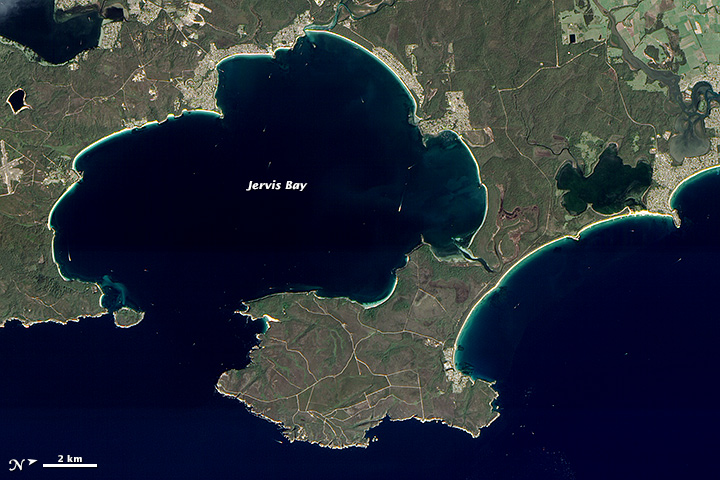NASA: Australia - Jervis Bay - New South Wales - 19.05.13
Posted by Ricardo Marcenaro | Posted in NASA: Australia - Jervis Bay - New South Wales - 19.05.13 | Posted on 17:42
Though ice never came anywhere near Australia during the Pleistocene Epoch—our
last Ice Age—it did help shape modern coastlines. Australia’s Jervis
Bay is a good example. Growing ice sheets pulled water out of the oceans
and lowered sea level around the world. When the Ice Age ended and sea
level rose again, a coastal river system in New South Wales was
inundated and became Jervis Bay.
The Advanced Land Imager (ALI) on NASA’s Earth Observing-1
(EO-1) satellite captured this natural-color image of Jervis Bay on
March 29, 2013. This image has been rotated such that north is to the
right.
Bright white sands line the coastline around Jervis Bay. When water
erodes rocks and carries them downstream or out to sea, softer minerals
slowly erode away. Quartz—composed of clear or white silicon dioxide
crystals, or silica—resists erosion longer than other rock types. So the
brilliant sands around Jervis Bay owe their color (or lack of it) to
the relentless action of water from old rivers, and rising and falling
seas over thousands of years. According to the Guinness Book of Records, the sands around Jervis Bay are the whitest in the world. These sands are also finer than typical ocean beach sand.
Just offshore from the white sands are the unusually clear waters of
Jervis Bay. Nearby streams are too small to carry heavy loads of
sediment that would cloud the water, and the surrounding wetlands and
forests also trap sediments that might otherwise drain into the bay.
Meanwhile, human settlement in the area has been relatively mild, so
runoff from agriculture and land disturbance are minimized.
Visitors to the Jervis Bay National Park may catch glimpses of
humpback whales, southern right whales, and dolphins off the coast. On
land, rare plant species thrive within the confines of the park. The
park even protects habitat for entire communities that have become
endangered, such as saltmarsh and floodplain forest. Plants here enjoy
abundant moisture, and monthly rainfall totals peak at more than 130
millimeters (over 5 inches) from April through June.
References
- New South Wales National Parks and Wildlife Service Jervis Bay National Park. Accessed April 15, 2013.
NASA Earth Observatory image by Jesse Allen and Robert Simmon, using EO-1 ALI data provided courtesy of the NASA EO-1 team. Caption by Michon Scott.
- Instrument:
- EO-1 - ALI
NASA: Australia - Jervis Bay - New South Wales - 19.05.13
Ricardo M Marcenaro - Facebook
Blogs in operation of The Solitary Dog:
Solitary Dog Sculptor:
byricardomarcenaro.blogspot.com
Solitary Dog Sculptor I:
byricardomarcenaroi.blogspot.com/
Para:
comunicarse conmigo
comunicarse conmigo
marcenaroescultor@gmail.com
For:
contact me
For:
contact me
marcenaroescultor@gmail.com
My blogs are an open house to all cultures, religions and countries. Be a follower if you like it, with this action you are building a new culture of tolerance, open mind and heart for peace, love and human respect. Thanks :)
Mis blogs son una casa abierta a todas las culturas, religiones y países. Se un seguidor si quieres, con esta acción usted está construyendo una nueva cultura de la tolerancia, la mente y el corazón abiertos para la paz, el amor y el respeto humano. Gracias:)
(::)



Comments (0)
Publicar un comentario